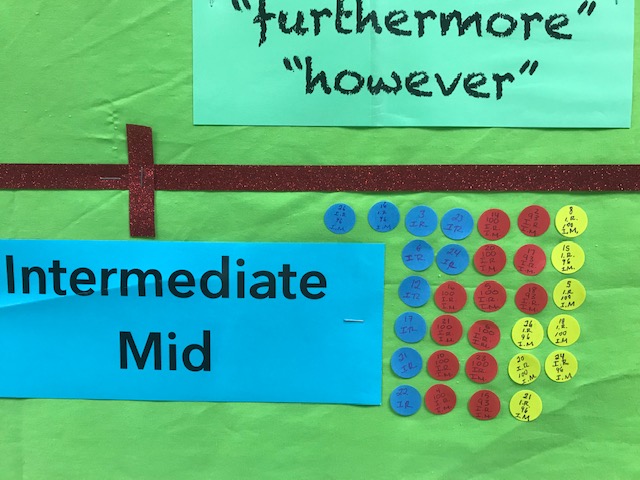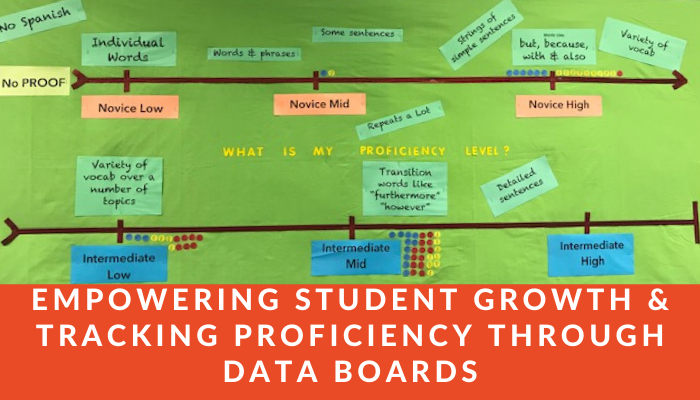A couple of years ago, I began to notice many bulletin boards inspired by the path to proficiency. As a teacher, I fell in love and stole the idea. After many hours of browsing through bulletin boards on Pinterest, I decided to go with the idea from Allison’s Mis Clases Locas Blog.
My Proficiency Path Awakening
In 2016-2017, I replicated Allison’s proficiency line inside my classroom. To be honest at this point, the proficiency line was in my classroom more for me than for my students. The school year ended, and I was debating about the posters and items in the walls prior to a new year approaching, SY 2017-2018, I decided that I wanted to keep the proficiency line. After all, it had helped me become more intentional with my teaching. I opted to keep it and I also told myself that I would begin to have “proficiency chats” with my students that year. I did, so I was glad that I kept it.
Growth Thanks to a Teacher Leader
Towards the beginning of 2018, I stumbled over one of Meredith White’s posts on the Path2Proficiency website. In there, she explained how she introduces ACTFL’s proficiency path and performance indicators to her students as well as how she guides them through setting up folders to track their proficiency early during the school year. I though that was a marvelous idea, so I also took it and adapted it fit my needs. Thank you Meredith!
Inspired by Meredith’s amazing blog post, I decided that 2018 was going to be the year where I would “preach” proficiency to my students until they could explain the path so well to others and lead them to take it seriously. It has worked. They now know what they are striving for and they even have class inside jokes about the performance indicators, and I could not be more proud.
Preaching Proficiency
This year, I find myself referencing the three modes of communication as I am explaining each class activities to the students or I may point to the board and ask students to tell me the mode of communication for the activities we might be doing at that moment. I have Allison’s beautiful I can statement posters to aid me with this. Students always know why we are doing the activities that we are doing in class that day. It helps to bring these things to their awareness, specially on those crazy school days when my class must compete with a pep rally or another exciting event (And I ask myself what could be more exciting than the acquisition of Spanish? ). When the students become aware of how an activity might help reach a performance indicator, they begin to focus more.
The Proficiency Line Became a Student-Centered Data Board
Another wonderful thing that came out of the proficiency line is the fact that I wanted a more visual representation of the performance of my classes, so I adapted my bulletin board into a student-centered data board. It now looks like this:

The timeline changes with every assessment (I add more dots), this allows me to clearly see what exactly are students and/or classes getting (or not getting) from my lessons so that I may modify, reteach as needed, or accelerate.
Setting Up the Proficiency Line with Data
- I talked to my students about performance indicators very early on in the semester and we set up our class folders as explained by Meredith.
- I assign a folder color for each class.
- I assign a number to each student to protect their privacy within the class. My students know very well that to me they are much more than just a number so we were comfortable with this.
- I purchased some round color coding labels from Amazon.
- After grading each assessment, I label a round dot of the color for that class with the student’s number; the mode of communication for that particular activity, for example, if it was an Interpretive Listening, I would label it as I.R.; the grade; and the performance indicator “unlocked.”
- I place the round dots on my bulletin board.

Let Your Proficiency Data Board Do the Talking
Just having the proficiency line alone from the very beginning created changes in my teacher mindset. It allowed me to become more intentional with proficiency based teaching.
As far as the current data & the proficiency line go, could I figure out where my students were standing without both? Yes, I have always been aware of the percentages of my classes’ performance on assessments regardless of the communication mode of the assessment. However, with the current proficiency line data board, it is evident that there is a greater sense of “we are in this together” between the students and the teacher. For example, although my students find out their actual grade before their dot is placed on the proficiency line, they are always eager to look at the board and actually find their dot to see if they met the class goal, which on Spanish III is usually intermediate mid. They also want to compare themselves to their classmates as much as I hate to say it, but that is up to them if they want to share their numbers and results. I don’t encourage this nor discourage it.
One thing that I noticed is that the location of this proficiency line & data chart is key so that both, students and teachers can reference it as needed. Often times, bulletin boards with paramount information can be easily faded into nothing due to its lack of presence and reference within the classroom.
I also want to add that setting it up may seem like a lot of work, but I leverage this as I have about two or three students each semester who are always willing to help. I call them my angels because they help me stay organized and they are happy to do so. It doesn’t take but 10 minutes and they label all of the dots for me, and all I have to do is put the dots on the proficiency line. I don’t delegate that last task because I want to visually connect each kid to his/her progress, but that is just me. Overall, the board and the data continue to serve as point of reference to support…everything we may do in class.
How do you track students’ progress? I would love to hear more about this topic.


Wow! Berta, thanks so much for your explanation. I am eager to incorporate more proficiency based assessments and goals into my classroom/instruction. I will definitely research more and use your ideas and examples as a guideline. Thank you for being such a wonderful inspiration to us here in Savannah-Chatham!
Thanks for reading Angela! You are an inspiration to me too 🤗!
Great post! I use the same “I Can…” statement posters. Your board is awesome, and I love that at any time you and the kids can quickly look over to see where everyone is now and where they are headed. Sooo great! Over the years I’ve tried a few different things, but what has worked well the past couple years are the proficiency level posters from Justin @spanishplans (spanishplans.org) that he calls “Get a Scoop of Proficiency” (blog post: https://spanishplans.org/2016/09/06/get-a-scoop-of-proficiency/ ). In class, we discuss and refer to them often because they help kids understand what the next level looks and sounds like. Recently, he blogged about ways to “level up” your proficiency and posted helpful materials to ensure we are on the right track. The materials also allow us more practice so that we can keep working toward leveling up (blog post: https://spanishplans.org/2019/01/31/leveling-up/ ). Thanks for sharing! 🙂
Thank you for stopping and for leaving a comment! Thanks for sharing what has worked for you. I have seen and shared the scoop of proficiency. I also love it! I, however, need to be even more intentional with leveling it up. I need to re-read Justin’s post with a magnifying glass and a paper and pen so I can take good notes and bring it to class. I provide assignment opportunities with leveling up options but not as clear as his post describes. Thanks for the suggestion!